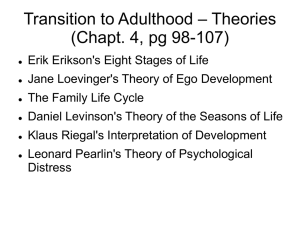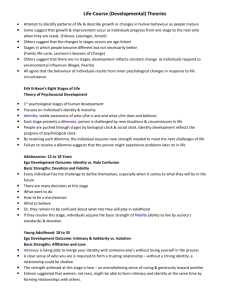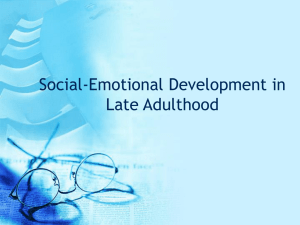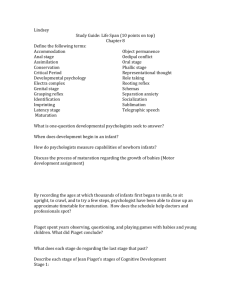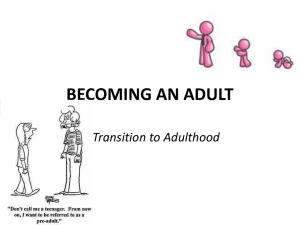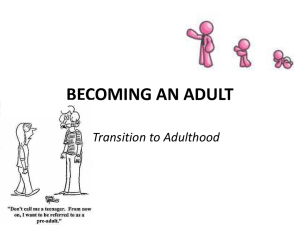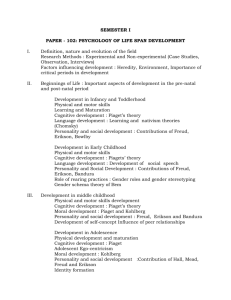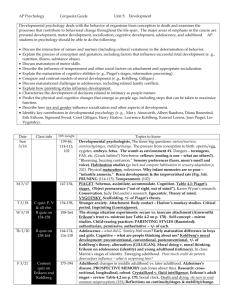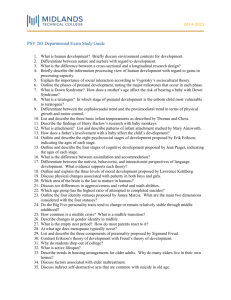12Unit two developmental theories
advertisement
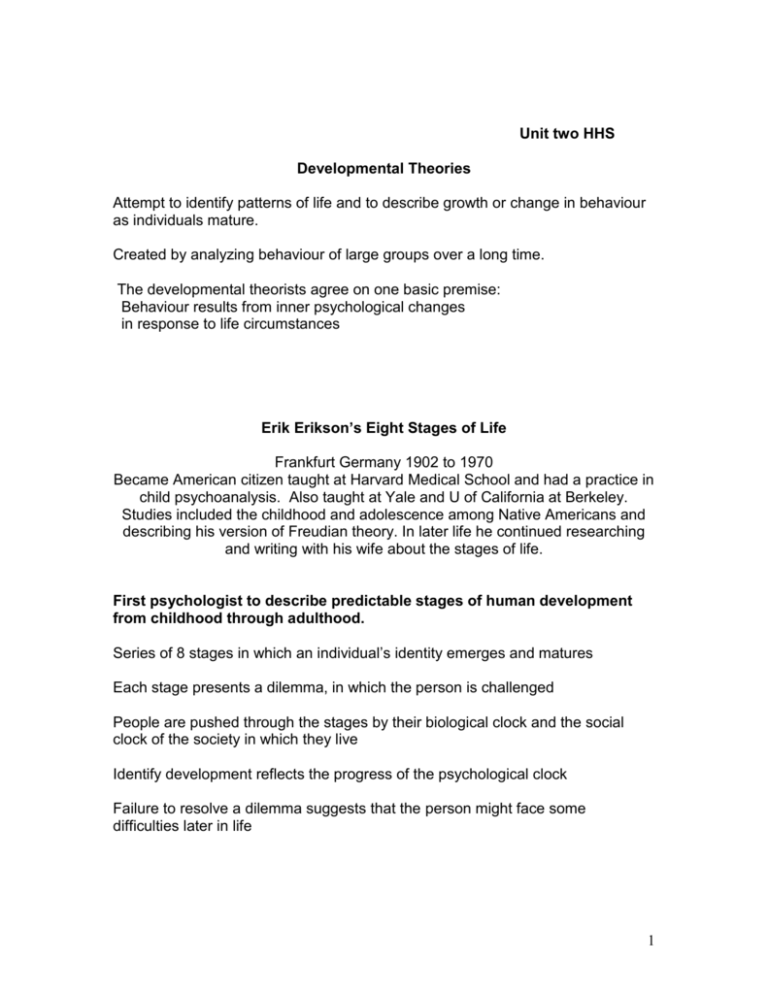
Unit two HHS Developmental Theories Attempt to identify patterns of life and to describe growth or change in behaviour as individuals mature. Created by analyzing behaviour of large groups over a long time. The developmental theorists agree on one basic premise: Behaviour results from inner psychological changes in response to life circumstances Erik Erikson’s Eight Stages of Life Frankfurt Germany 1902 to 1970 Became American citizen taught at Harvard Medical School and had a practice in child psychoanalysis. Also taught at Yale and U of California at Berkeley. Studies included the childhood and adolescence among Native Americans and describing his version of Freudian theory. In later life he continued researching and writing with his wife about the stages of life. First psychologist to describe predictable stages of human development from childhood through adulthood. Series of 8 stages in which an individual’s identity emerges and matures Each stage presents a dilemma, in which the person is challenged People are pushed through the stages by their biological clock and the social clock of the society in which they live Identify development reflects the progress of the psychological clock Failure to resolve a dilemma suggests that the person might face some difficulties later in life 1 The dilemma during adolescence and early adulthood is Identity versus role confusion (Erikson, 1980) In resolving this dilemma, individuals acquire the basic strength of fidelity, enabling people to make choices that serve the needs, strengths and interests of themselves and later of others. Intimacy versus isolation is the dilemma of early adulthood Being able to merger your identify with someone else’s without losing yourself in the process is intimacy. In this case, true intimacy is being able to trust a person enough to reveal your personal thoughts and feelings to him or her. Erikson suggested that without an identity formed in the previous stage, relationships would be shallow. If not connecting with others … individuals feel lonely. The basic strength that is acquired by resolving the connect with others is acquired by resolving the dilemma of intimacy versus isolation. Erikson thought women may develop identity and intimacy at the same time because they might develop their identities through relationships with others. They may acquire the strengths of fidelity and love at the same time. The same idea has been suggested by Carol Gilligan (1982) in her book “A Different Voice”. She based her studies on women and concluded that a woman determines who she “is” and how to be a women in terms of a relationship, whereas men, usually cannot commit to others until they are sure of their own identities. Adults focus on their contribution to society in the next stage of life, to Erikson, this was generativity versus stagnation. Most people accomplish this by having children. Some attain this through work, it requires the development of intimate relationships on the social clock because it requires fidelity and love. Determine who you want to be and what you want to do so that you are true to yourself, and then whom you want to be with so that you can share yourself with others. 2 Jane Loevinger’s Theory of Ego Development Identified ten stages in the formation of the ego. The ego is a term introduced by Sigmund Freud, meaning the understanding of self. Ego develops in infancy with the understanding that you are separate from your mother. Loevinger describes this time as when we are autonomous. The autonomous self is a concept that includes being a self-reliant person who accepts oneself and others as multifaceted and unique. Her stages are determined solely by the individual’s psychological clock. She says that few adults ever achieve full ego but strive toward it for a lifetime. Young adults are at a transitional stage, self – aware level between the conformist stage and the conscientious stage. Young adults at this stage begin to understand and accept individual differences and distinguish the variations in feeling s and opinions that make us unique. Similar to the ideas of Erikson, she says that individuals require a clear sense of themselves before they can form truly intimate relationships with others. She differs from Erikson in that through her research , she concluded… Progress from one stage to the next is determined by psychological clock, not by chronological age or the social environment. The Family Life Cycle Early adulthood is a stage where individuals are launched from their families. Three developmental tasks must be mastered for this to happen. 1. Young adults must form an identity separate from the family of origin. Called individuation. 2. Must develop new intimate relationships with peers outside the family to provide the social and emotional support they need. 3 3. Must make first tentative commitment to a career or workplace role. These three tasks enable young adults to become self-sufficient adults. Relationship between the parents, play an important role. Relationship between parent and child must change to become less hierarchical . Parents must be tolerant of differences of opinion . Parents must accept the fact that the “child” is forming new intimate relationships. The family life-cycle theory emphasizes that development involves change in response to a crisis so that the family can move on to a different stage. Daniel Levinson’s Theory of the Seasons of Life Early adulthood lasts 25 years starting about age 17 and ending with the transition to middle age in the early forties. During the transition from 17 to 22 years of age, an individual must leave behind adolescent life and begin to prepare an adult life structure. He wrote of separation from the family, however he emphasized changes in the attachment between adult child and parents- not necessarily physical separation. During the years from 22 to 28, is the entering the adult world period. This “meshing of self-in-world” is what Levinson called the life structure or pattern or design of life. Four major tasks of this period are, 1. 2. 3. 4. Forming a Dream and giving it a place in the life structure Forming mentor relationships Forming an occupation Forming love relationships, marriage, family The Dream, is the individual’s sense of self in the adult world and is the core of the life structure. Men usually describe the Dreams involving occupational accomplishments, but some men and many women describe the Dream related to community and family. (Levinson 1996) The age 30 transition occurs between the ages of 28 to 33. 4 Individuals re-evaluate the life structures that they formed in their early twenties to determine whether they are living out their dreams. Many of Levinson’s subjects described this as a time to “get real” , settling down in their thirties. Klaus Riegel’s Interpretation of Development American psychologist suggested that development in adulthood occurs not in predictable stages but as individuals adjust in response to the interaction of both internal and external changes. He accepts an internal biological clock and a changing external social clock. Four interrelated internal and external dimensions of development, 1. Individual psychological dimension describes emotional maturity and independence and the maturity of mental processes. 2. The individual biological dimension , physical and sexual maturity 3. Cultural-sociological dimension expectations and opportunities that each society difines for individuals. 4. Environmental dimension physical, economic and political environment that each society defines for individuals. According to Riegel, development occurs when a change in one dimension requires an adjustment in one or more of the other dimensions. For example: if people are physically mature and emotionally ready for marriage, they will marry, if they are old enough according to the culture and the society in which they live and if they can afford to live independently within the economic environment. 5 Leonard Pearlin’s Theory of Psychological Distress American sociologist attempted to rationalize how development can be unique to each individual yet appear to occur in a common pattern. Disagreed with stage theories, saying that adulthood is not a series of transitions but rather a lifetime of continuous change in which individuals may experience occasional periods of stability. Four elements determine the path that individual lives will take; 1. Characteristics like gender, race, intelligence, family background, personality and education. 2. The range of skills individuals have for coping with stress or change 3. the availability of social support networks 4. the nature and timing of stress that requires response. People are able to change the life structure at any time. He suggested that there are similarities in life flow because individuals change in response to similar external circumstances and stresses that affect their lives. Such stresses as leaving school, starting work, getting married, are scheduled by the social clock of society and are predictable. So… if we can predict and anticipate role changes. Pearlin says that the other developmental theorists have observed patterns that are a cohort effect. He thinks the changes in behaviour result from socialized responses to a common social clock rather than from age-linked inner changes. 6 Gail Sheehy In 1976,”one of the ten most influential books of our time” was published. (Library of Congress survey) Passages: The Predictable Crises of Adult Life (1976) Using case studies Sheehy described the life transitions of adulthood. She is not a professional psychologist; she is a journalist. In writing her books she used the methodology of psychological research to serve a journalistic purpose. In writing Passages she set out to, 1. locate inner changes common to each stage of life 2. compare developmental rhythms of men and women 3. examine the crisis that couples can anticipate. Her predictable crisis match the periods that Daniel Levinson outlined. Her names are more creative however.. Early adult transition as Entering the adult world as Age 30 transition as Pulling Up Roots The trying Twenties Catch-30 Unlike Levinson’s early work, she examined the lives of both men and women and their lives together. 7 More theories of Development Sigmund Freud, Jean Piaget, Charles Horton Cooley and George H. Mead developed a model of personality with three main parts: (1962 [1930}) Id ego and superego For Freud, the id represents the basic drives or instincts for food, sex and so forth. These require gratification but are unconscious. The id is present from birth. The ego, Freud believed emerges from the id and represents an attempt to balance the child’s innate drives with the realities of life. We learn that we can’t have everything we want. The superego is the individual’s learning of and internalization of the culture of the groups in which he or she participates. The superego therefore involves the development of personal conscience. As a consequence of socialization the child moves from a demanding the satisfaction of the basic needs to developing a moral sense of right and wrong, sense of appropriateness and guilt, depending on the cultural guidelines learned wit others. In contrast to theories that concern personality development as a whole, the work of Jean Piaget is more limited in focus. It concerns cognitive development, or the way we learn to think. Piaget was the first to show that cognitive development is as much a social as a psychological process. He identified four stages of cognitive development. Sensorimotor-from birth to age 2, baby will suck, touch, look and listen. The child is without thought knowing the world only as a consequence of direct experience. Preoperational - from ages 2 to 7. Children experience the world mentally by using and understanding symbolic communication. Capable of thinking about things they are not experiencing directly. 8 However, they continue to perceive the world only from their own point of view and are not yet able to see things from others’ perspectives. Concrete operational – typically develops between 7 and 11. Able to think in terms of cause and effect. Can eventually perceive things from the others’ point of view. Formal operational - is reached when the child id able to use highly abstract through and to imagine alternatives to reality. An imagination is developed to allow thinking and fantasizing beyond the immediate situation or reality. Piaget believed that people possess considerable ability to shape their own social world. He contributed greatly ot our sense of the human mind as an active and creative source and interpreter of reality. ___________________________ George H. Mead- contributed to still more sociological conception of the development of self. According to Mead 1934, the self is not biological and does not exist at birth but develops only as a consequence of social experience. By using symbols, people create and share meanings about their situation. We understand the actions of others in a particular situation as we can imagine the situation from the others’ point of view. Charles Horton Cooley- saw the self as social product. Self-image emerges as a product of group involvement and communication with others. Used the image of the “looking glass self” (1902) We define ourselves to see conceptions about ourselves, our feelings and what we are, as others see us. 9
